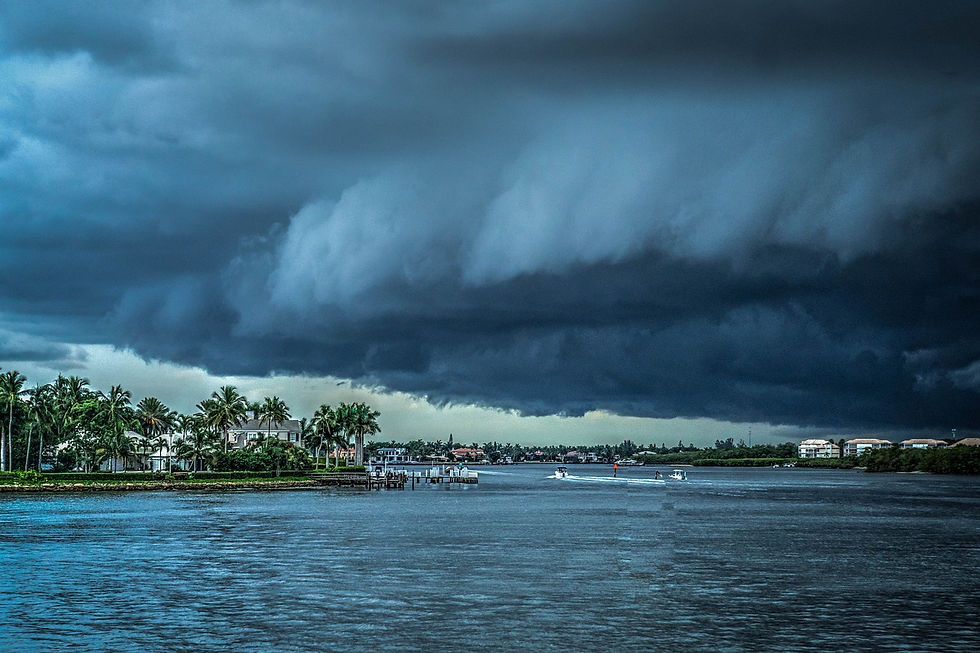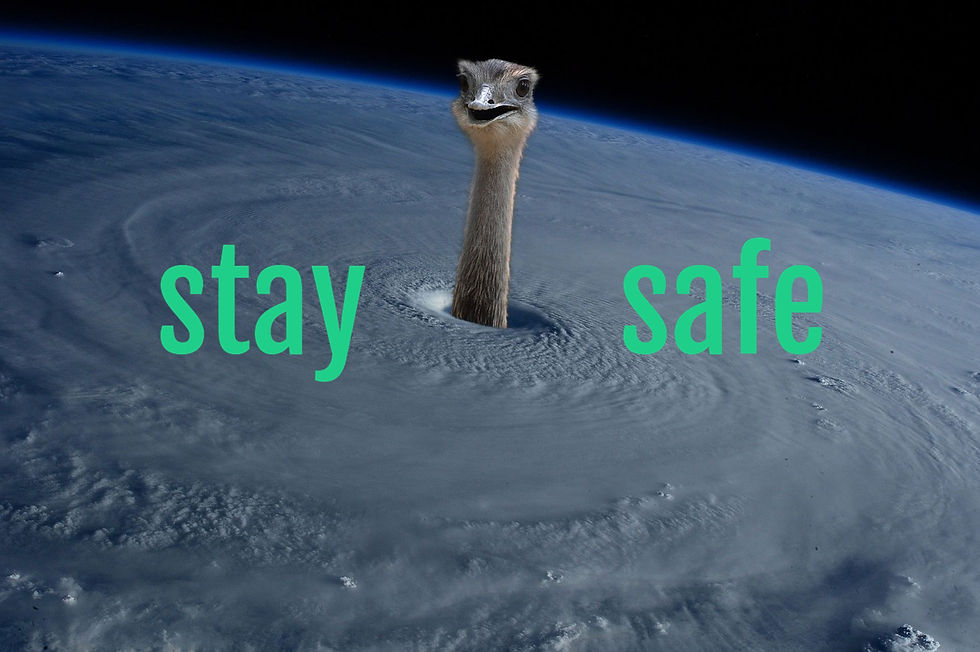
As a foreigner living in a Caribbean nation like Belize, being aware and ready for the threat of tropical storms and hurricanes is a necessity of seasonal living. Like everywhere else, hazards exist, be it ice storms in Canada, wildfires and tornadoes in the US, earthquakes in Italy, and tsunamis in Japan. Living alongside potential dangers is just part of life on earth; for Belize, it's hurricanes. For those living in or considering moving to Belize —or any of its Central American neighbours— knowing what to expect and being prepared is an integral part of life. And having the knowledge and a plan in place makes handling such occurrences —rare in Belize’s case, thankfully— less stressful.
A Season for Turbulent Weather

Hurricane season runs from June 1st to November 30th and produces an average of ten tropical storms, with approximately six reaching hurricane status. In typical meteorological fashion, these statistics vary across reporting organizations and institutions, with some claiming higher averages of 12 hurricanes, with six reaching category three or higher. A storm's strength is categorized by a number from one to five, known as the Saffir-Simpson Hurricane Scale, with one being the weakest hurricane and five the strongest.
Now I realize that “weak hurricane” sounds like an oxymoron, as to acquire such a status, a storm must reach and sustain wind speeds of over 74 miles per hour (118.4 km/hour). Winds at these speeds can break windows, sever tree limbs, topple shallow-rooted trees, damage roofing and siding, and down powerlines, not to mention the heavy rainfall and flooding they cause. And that's just a CAT One; potential storm damage increases from there. I also don’t want to downplay tropical storms, which can have winds from 39- 73 miles per hour, and cause damage to property, buildings, and trees.
Belize Weather: Relaxed, Like Its People

We are at the height of the 2024 hurricane season, which many have predicted will see above-average activity. Luckily for Belize, it's been pretty quiet this year, as in most years. Thanks to its geographical location, Belize is a great place for expats looking to safely move to or retire in its vibrant coastal communities, like Corozal, Dangriga, Punta Gorda, Hopkins, and Placencia.
Belize and its neighboring Central American countries experience less frequent and intense weather than the Northern and Eastern Caribbean or coastal Southeastern United States due to various geographical and meteorological factors:
Western Caribbean Location
Belize and much of Central America are farther west in the Caribbean basin. Many hurricanes form in the eastern Atlantic and intensify as they move westward, affecting the eastern Caribbean islands. Storms generally lose steam over land masses due to the absence of warm water, which they use as fuel.
Wind Patterns Steer Storms Away
Wind patterns and steering currents are significant reasons why Belize doesn’t experience as many hurricanes. The prevailing easterly trade winds tend to steer hurricanes towards the northern Caribbean and Gulf of Mexico, often curving them away from Central America. Large-scale atmospheric patterns often guide hurricanes on a more northwesterly track, which can take them north of Central America.
Mountains as Natural Barriers
Geographical features like the mountainous terrain of Central America can disrupt hurricane formation and weaken existing storms. For example, Honduras has a coastal mountain range that can act as a barrier. Interesting fact: you can actually see the mountains of Honduras from Placencia on a clear day!
Cooler Waters Reduce Storm Strength
Water temperature is an important contributing factor, too. While the entire Caribbean is warm, the western Caribbean, where Belize is located sometimes has slightly cooler waters compared to the eastern Caribbean, which can be less conducive to hurricane intensification. I know it doesn’t seem like it at times when the sea feels like bath water.
Be Prepared: Hurricanes Still Possible
However, hurricanes can make landfall in the region, and Central America and Belize are not immune. So, anyone who lives here or plans to move here must be aware of this fact and know what to do if it occurs. However, being knowledgeable and prepared makes experiencing a strong weather event less daunting and intimidating.
The Hurricane Preparation Checklist for the Unfamiliar Expat
So, let’s go through what the expat who is green —like we were and still are I suppose— to these types of weather events can do to be hurricane-ready in Belize. We did most of these things in our preparation for Lisa and there are things on this list we would do better next time too.
1. Create an Emergency Weather Plan
Knowing what to do and when is essential for any preparedness plan. Your plan will dictate your actions, like boarding up your house, where you will go if you need to evacuate, and what supplies you will have or need to get.
You should know your evacuation routes and if there are any storm shelters in your area. In Placencia, the evacuation route is Placencia Road. The nearest shelter for the communities along the peninsula is Georgetown Technical High School, on the Southern Highway heading towards Independence. Click here for a list of storm shelters in Belize. Many communities organize their own shelter-in-place points, with one or more members offering their home for others to hunker down in. If you do this next to the ocean, reside on a second floor in the case of a significant storm surge.
You should also determine a communication plan to establish how and when to contact friends and family members and set a meeting point if sheltering in a group. Remember that BEL will shut off power to areas under threat for safety reasons, which often means there is no internet connection, either locally or regionally.
2. Preparing Your Hurricane Supplies

Before your first hurricane season starts, you should gather and store a supply of storm essentials. Below is a list of some critical items for a hurricane preparedness kit. Be sure to assess what you need, as everyone’s kit will differ based on their situation, preferences, and the number of people it will support.
List of Essential Hurricane Supplies
Potable water: one gallon/person/day for at least three days and a compact secondary source of water purification.
Non-perishable food in hard plastic or glass containers to keep out moisture and bugs. Last year, my wife and I purchased a small bucket of freeze-dried food containing over 100 portions, with a shelf life of 25 years, which was a great addition to our emergency supplies.
Backup prescription medications (if you require meds).
A well-stocked first-aid kit.
A wireless cell phone charger (provided your phone is compatible).
Important documents: Keep your passport and other important papers in a waterproof folder or pouch.
A large tote or totes to put all the above in.
Gerry can of fuel for your vehicle.
Pet food for the fur fam (if you have them).
Plywood for boarding up your home.
Prepare Wisely: Because Your Freezer Pizza Won’t Last Forever

Another good thing is a reliable backup power source ready to use after the storm. Standard options are a gas or diesel generator (<— we have this one), a reserve store of power from your existing solar setup, or a fully charged portable solar battery, as we have. You can use these to run fans, small appliances, and even a fridge for up to eight
hours (depending on the model), which is excellent, especially if there is a delay with power returning to the grid.
We also ensure a reserve tank of liquid propane (LP) gas with a portable gas stove for cooking, boiling water for coffee and tea, or water purification. But, please exercise caution when using a gas stove in an emergency and do not use it indoors. The exhaust from ignited LP gas contains harmful carbon monoxide.
It's Go Time
Lastly, you may consider assembling a “go bag” of clothing and other personal items so you aren’t scrambling in the event of an emergency evacuation.
Once you have put your kit together, ensure you routinely inspect your supplies, remove and restock expired/expiring items, and replace or upgrade items as needed. It also helps to build the kit over time, as purchasing all the items above can run anywhere from USD 500- 1500.
3. Stay Informed
A critical aspect of a properly executed hurricane preparedness plan is staying informed. Regularly monitor weather alerts throughout the season, join Facebook groups related to hurricane watches in your area, watch and subscribe to weather-related YouTube channels (I like Mr. Weatherman as he is honest, to the point, and doesn’t fearmonger for views), and download helpful weather apps like Zoom Earth. Knowing where storms are, how fast they develop, and when and where they will make landfall is essential to staying safe during storm season.
4. Insurance
Take out hurricane insurance for your home. Despite misinformation circulating on Facebook, you can insure a wood-framed home in Belize. Your premium will be lower with a masonry home of a similar size, but it is still available for wood construction. When renewing, review your coverage each year to ensure your home insurance covers wind and flood damage, and update it if necessary.
If you plan to build a wood-framed home, check out The Ultimate Expat Guide to Building a House in Belize Part One and Two to learn how to increase the structure of your home to make it storm-ready.
5. Secure Your Home

When a storm is imminent, take immediate action to protect your house and property. Begin the necessary preparations quickly, whether you hire someone or do it yourself, to avoid working as the storm hits. Following the tips from point three above, you’ll have enough time to prepare. One key task is securing your windows and doors with shutters.
Some homeowners along the coast in Belize opt to install roll-up steel shutters, while others choose traditional wood shutters beside each window. Many, who prefer a cleaner facade or don't have the budget for the expense of the steel option, keep a stash of plywood for such occasions. Shuttering your windows and doors will protect them from projectiles and being blown in, as well as water penetration. In the grand scheme, it's an affordable and effective way to prevent repair costs (compared to replacing them).
Batten Down the Hatches (And Your Patio Furniture Too!)
On the ground level, remove everything from the floor and place it as high as possible to protect it from flooding and storm surge. Put away or tie down patio furniture and other loose items. Trim trees that are overhanging the roof or close to your house. If you have coconut trees bearing fruit, remove them, as they can become, in effect, organic canon balls.
Ultimately, use your common sense here. If you think it might blow away or get damaged, then take the appropriate action to protect it if it has meaning or value.
Turn off the main power breakers in the house (in case flood waters reach the height of outlets on the main floor). The electrical utility provider, in this case BEL, will shut off the power grid ahead of the storm. Turning off your main power to the house will have the added benefit of protecting the home's electrical wiring, components, and anything plugged into it from power surges once power returns.
6. Evacuate if Advised
If you plan to leave, leave early to avoid the possibility of last-minute congestion. Take your go-bag, emergency supplies, important documents, and other valuables you’ve previously collected.
Again, step three will inform you of what local authorities are asking residents to do.
However, whether you choose to leave or not and for what storm category is a personal choice. Your decision will probably hinge on your assessment of your overall preparedness, your home’s construction, and the size of your cojones.
My Belizean Hurricane Experience
While thankfully, I have not experienced a hurricane, we had a scare not long after arriving here.
In November of 2022, Hurricane Lisa landed in Belize City, approximately 100 miles from our house in Maya Beach, on the Placencia Peninsula. Being green to such a thing and having a newly built home to protect, we sprung into action, purchasing plywood to craft custom shutters and boarded up the place —just in time for… the storm to move north of us. We spent the evening drinking cocktails on our back deck and fishing in the canal during the planned power outage (a storm precaution).
It Ain't All Cocktails and Fishing Poles
Even though our efforts were for naught, I am grateful we didn't have to weather the storm. It was a great exercise in storm preparedness and gave us insight into what we must do to be safe and ready. Plus, we now have storm shutters cut, assembled, and labeled for future use. It also taught us to be more diligent in our monitoring efforts, as the track and timeline of these systems are often well established ahead of time and had we been more aware, we would have known the storm would pass us by.
When I talked to my friend Rick (try his coffee!) days after, he laughed and emphatically said “no” when I asked him if he had shut up. He was well-informed and knew the hurricane would be nowhere near Placencia.
Staying Safe and Prepared Throughout Hurricane Season

While the risk of experiencing a hurricane in Belize is far lower than that of other Caribbean nations, it's still important to be aware and prepared. It could very well be that you will never need to use your supplies but having them ensures you can act in the event you do. By following these steps, you can better protect yourself, your family, and your home during hurricane season. Preparation is vital to minimizing the impact of hurricanes and ensuring a swift recovery. From assembling a comprehensive emergency kit to securing your home and knowing what to do after a storm, being proactive can make all the difference. Remember, a well-thought-out plan and timely actions can help you weather the storm with greater confidence and safety.
Stay safe out there!
Thanks for reading! If you are interested in other works of mine, check out Simo's Substack, the Lili Art Blog, or my award winning self-published book. If you want to support this blog so I can continue providing valuable information on Belize, consider donating, subscribing, or clicking an ad. And a special thanks to those readers who have shown their support; it is greatly appreciated!
Comments